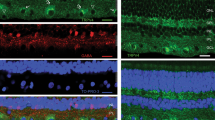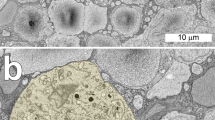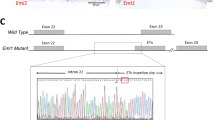Abstract
THE retina is sensitive to light stimuli varying over more than 12 log units in intensity. It accomplishes this, in part, by switching between rod-dominated circuits designed for maximum utilization of scarce photons and cone circuits designed for greater acuity. Rod signals are integrated into the cone pathways through AII amacrine cells, which are connected by gap junctions both to other AII amacrine cells and to cone bipolar cells. To determine the relative permeabilities of the two junctional pathways, we have measured the distribution of biotinylated tracers across this heterologous cell assembly after injecting a single AII amacrine cell. We found that neurobiotin (relative molecular mass, 286) passed easily through both types of gap junctions, but that biotin-X cadaverine (relative molecular mass, 442) passed through AII/bipolar cell gap junctions poorly compared to AII/AII gap junctions. Thus, the AII /bipolar cell channel has a lower permeability to large molecules than does the AII/AII amacrine cell channel. The two pathways are also regulated differently. Dopamine and cyclic AMP agonists, known to diminish AII–AII coupling1, did not change the relative labelling intensity of AII to bipolar cells. However, nitric oxide and cGMP agonists selectively reduced labelling in bipolar cells relative to AII amacrine cells, perhaps by acting at the bipolar side of this gap junction. This suggests that increased cGMP controls the network switching between rod and cone pathways associated with light adaptation.
This is a preview of subscription content, access via your institution
Access options
Subscribe to this journal
Receive 51 print issues and online access
$199.00 per year
only $3.90 per issue
Buy this article
- Purchase on Springer Link
- Instant access to full article PDF
Prices may be subject to local taxes which are calculated during checkout
Similar content being viewed by others
References
Hampson, E. C. G. M., Vaney, D. I. & Weiler, R. J. Neurosci. 12, 4911–4922 (1992).
Kolb, H. & Famiglietti, E. V. Science 186, 47–49 (1974).
Strettoi, E., Raviola, E. & Dacheux, R. F. J. comp. Neurol. 325, 152–168 (1992).
Sterling, P. A. Rev. Neurosci. 6, 149–185 (1983).
Bennett, M. V. L. et al. Neuron 6, 305–320 (1991).
Beyer, E. C., Paul, D. L. & Goodenough, D. A. J. Membr. Biol. 116, 187–194 (1990).
Rae, J. L. Curr. Top. Eye Res. 1, 37–90 (1979).
Swenson, K. L., Jordan, J. R., Beyer, E. C. & Paul, D. L. Cell 57, 145–155 (1989).
Werner, R., Levine, E., Rabadan-Diehl, C. & Dahl, G. Proc. natn. Acad. Sci. U.S.A. 86, 5380–5384 (1989).
Bruzzone, R., White, T. W. & Paul, D. L. J. Cell Sci. 107, 955–967 (1994).
Flagg-Newton, J., Simpson, I. & Loewenstein, W. R. Science 205, 406–407 (1979).
Brink, P. & Dewey, M. M. Nature 285, 101–102 (1980).
Zimmerman, A. L. & Rose, B. J. Membr. Biol. 84, 269–283 (1985).
Veenstra, R. D., Wang, H.-Z., Beyer, E. C. & Brink, P. R. Circ. Res. 75, 483–490 (1994).
Törk, I. & Stone, J. Brain Res. 169, 261–273 (1979).
Voigt, T. & Wässle, H. J. Neurosci. 7, 4115–4128 (1987).
Witkovsky, P. & Dearry, A. Progr. Ret. Res. 11, 247–292 (1991).
Koistinaho, J., Swanson, R. A., De Vente, J. & Sagar, S. M. Neuroscience 57, 587–597 (1993).
Massey, S. C., Mills, S. L. & De Vente, J. Invest. Ophthal. Vis. Sci. (suppl.) 34, 1382 (1993).
Vaney, D. I. Progr. Ret. Res. 13, 301–355 (1994).
Yamamoto, R., Bredt, D. S., Snyder, S. H. & Stone, R. A. Neuroscience 54, 189–200 (1993).
Shiells, R. & Falk, G. Neuroreport 3, 845–848 (1992).
Slaughter, M. M. & Miller, R. F. Science 211, 182–185 (1981).
Shiells, R. & Falk, G. Proc. R. Soc. Lond. B 242, 91–94 (1990).
Nawy, S. & Jahr, C. E. Nature 346, 269–271 (1990).
Yamashita, M. & Wassle, H. J. Neurosci. 11, 2372–2382 (1991).
Nomura, A. et al. Cell 77, 361–369 (1994).
Tian, N. & Slaughter, M. M. J. Neurophysiol. 71, 2258–2268 (1994).
Mills, S. L. & Massey, S. C. J. comp. Neurol. 304, 491–501 (1991).
Author information
Authors and Affiliations
Rights and permissions
About this article
Cite this article
Mills, S., Massey, S. Differential properties of two gap junctional pathways made by AII amacrine cells. Nature 377, 734–737 (1995). https://doi.org/10.1038/377734a0
Received:
Accepted:
Issue Date:
DOI: https://doi.org/10.1038/377734a0
This article is cited by
-
An offset ON–OFF receptive field is created by gap junctions between distinct types of retinal ganglion cells
Nature Neuroscience (2021)
-
NMDAR-mediated modulation of gap junction circuit regulates olfactory learning in C. elegans
Nature Communications (2020)
-
Connexin-36 distribution and layer-specific topography in the cat retina
Brain Structure and Function (2019)
-
Electrotonic signal processing in AII amacrine cells: compartmental models and passive membrane properties for a gap junction-coupled retinal neuron
Brain Structure and Function (2018)
-
Is dopamine transporter-mediated dopaminergic signaling in the retina a noninvasive biomarker for attention-deficit/ hyperactivity disorder? A study in a novel dopamine transporter variant Val559 transgenic mouse model
Journal of Neurodevelopmental Disorders (2017)
Comments
By submitting a comment you agree to abide by our Terms and Community Guidelines. If you find something abusive or that does not comply with our terms or guidelines please flag it as inappropriate.



